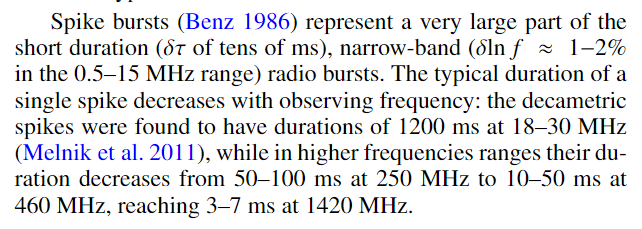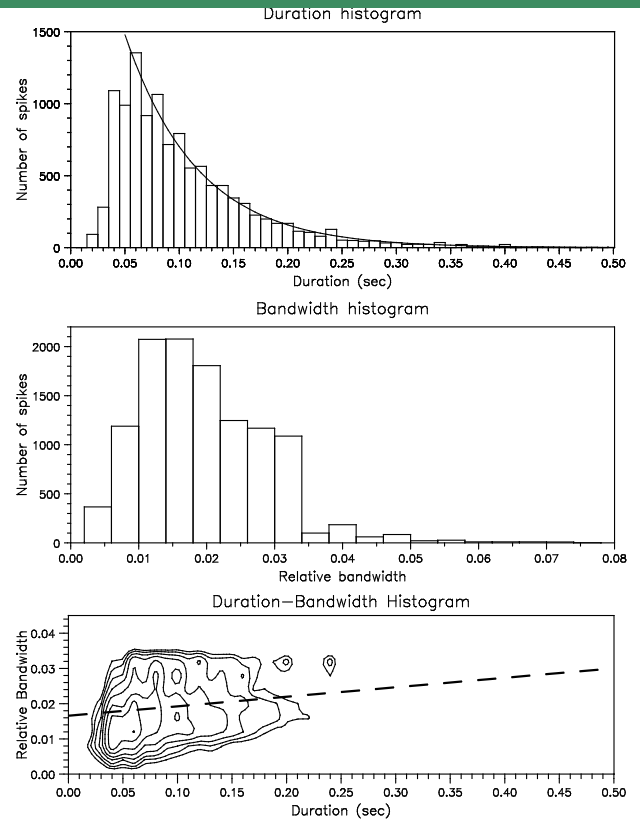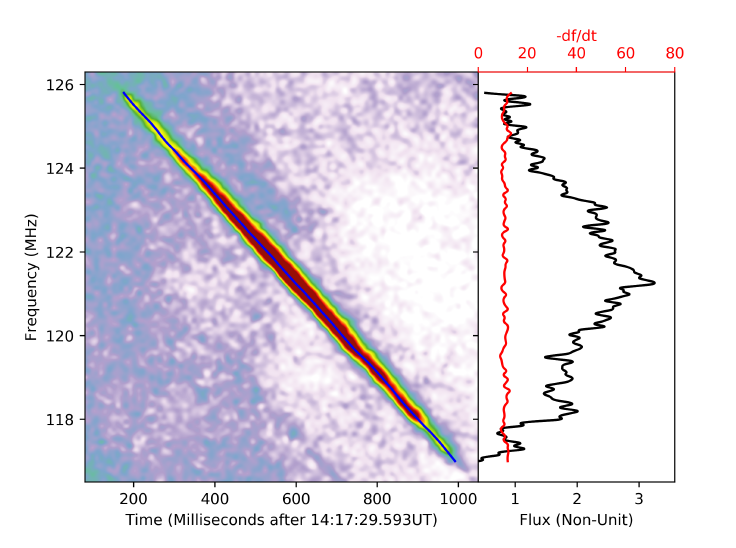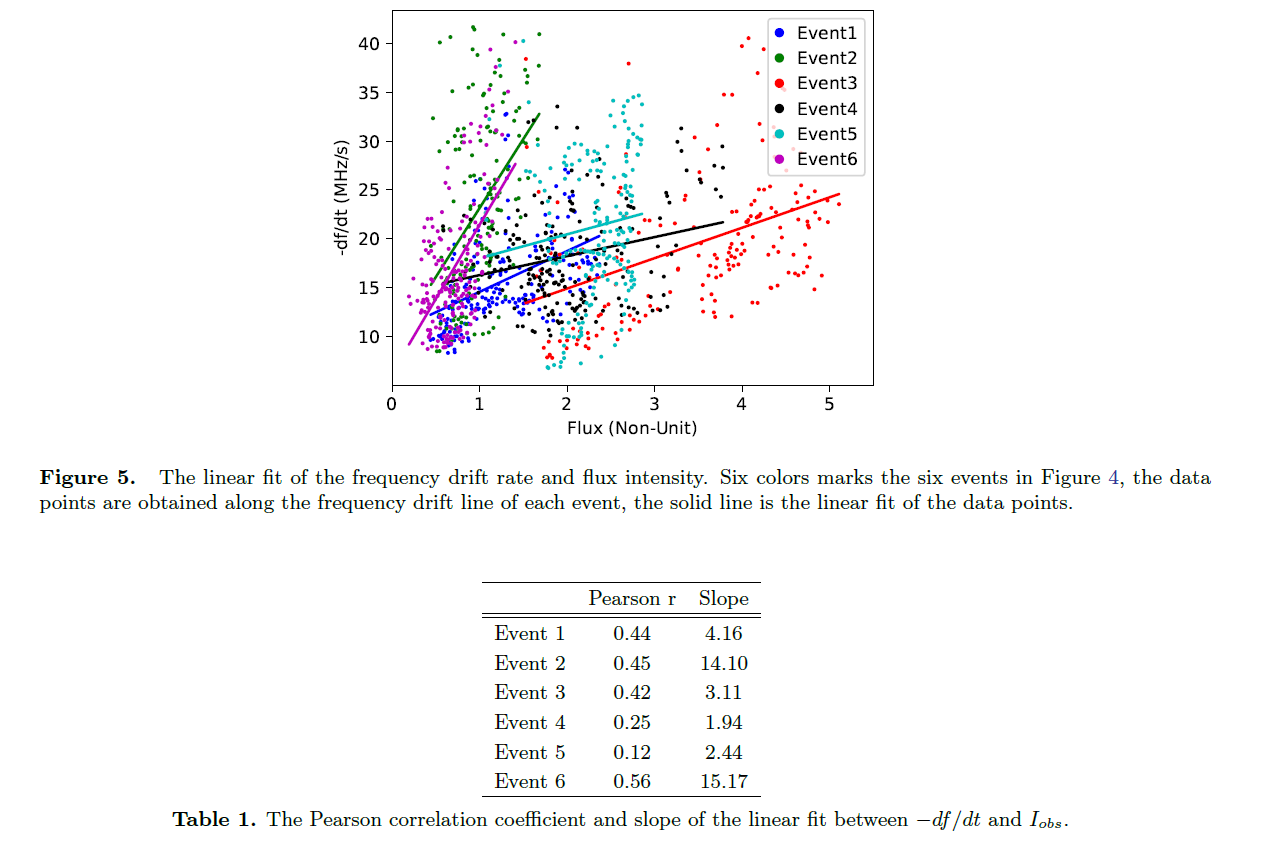半峰全宽 Full width at Half maximum
测量尖峰的带宽,使用小波变换,从频谱图的角度来计算的。
source:朱艳鑫,等:太阳微波爆发中尖峰辐射的带宽计算
1 尖峰爆发的介绍,典型频率,典型持续时间,持续时间随频率的增加呈现下降的趋势。
(High resolution observations with Artemis-IV and the NRHI. Type IV associated narrow-band bursts)
关于尖峰事件的介绍很详细。

该论文中还涉及到了尖峰事件的形态特征(morphological characteristics)。

工作简短介绍


画的这些图也可以借鉴。
source: Flaring loop parameters estimated from solar decimeter type U-like and type J-like fine structures
提到:Such emissions(The fine structures) are variants(变体) of the type III bursts.
提到fine structure 研究意义,产生缘由
Type U(inverted U)bursts are mainly observed at low frequencies, at meter and decameter wavelengths.(300K-3MHz,30MHz-300MHz),rarley be observed in the decimeter band(300MHz-3GHz)
Type J bursts are variants of typeU bursts.
但是其频率范围i有100M,这算是fine structure吗
《The frequency drift and fine structures of Solar S-bursts in the high frequency band of LOFAR》 PeiJin Zhang
there have been very few studies on the fine structure of solar S-bursts because of the limited sensitivity and resolution of previous observations. (this situation is the same as spike bursts.)

In the left sub-panel of Figure, the blue line represents the center line of the S-burst, namely the frequency drift line.(Using ACBone algorithm)
we can obtain the frequency drift rate(red curve) and the flux intensity(black curve) of the S-burst at different frequencies

数据分析方法:Pearson test and a linear fit between the frequency drift rate and the flux intensity.
《A type III radio burst automatic analysis system and statistic results for a half solar cycle with Nançay Decameter Array data》 PeiJin Zhang
computer vision methods are used in this automatic analysis system.
reveal that type III radio bursts, and other types of solar radio emission as well, play important roles in understanding the physical processes of energy release, particle acceleration, and particle transport in the solar atmosphere and interplanetary region.
methods:
1.the Canny edge detector: data preprocessing to detect and remove the bad data from instrument or environment interference.
2. Hough transform: recognize the line segments corresponding type III radion bursts on the spectrum image. we can get the starting time, frequency,(starting and stopping)
transforms an image from the x-y space to the ![]() . (x-y is the position of a point in the image(the row and column index of the pixel))
. (x-y is the position of a point in the image(the row and column index of the pixel))
straight line segments to localized peaks.(longer segments producing bigger peaks)
3. A modified active contour model : track the backbone of the backbone of the burst to obtain the frequency drift rate and intensity of the burst at different frequency channels.
The raw data need processing:
1. preprocessing: split the raw data into small segment, subtract the slowly varying background signal, eliminate the bad data segments( containing device calibration or lightning discharges).
2. recognition whether the data segment has event of type III radio bursts or not.
image binarization:
transform the grayscale image to a binary image(each pixel: one or zero) : methods: threshold method and local-maxmum mathod.
threshold method: the intensities of type III radio bursts are generally the top 15% of pixels ( put these pixels to 1 on the binary image and rest of them to 0).
相当于点亮某个像素。Lighting! The new thoughts!
image binarization->Hough peaks->generate line segment
Hough transform method: input: Binary image

the two points in one line that reflect to the other space is focus on one point( 可以作为判定定理,若两个点位于一条线,则在ab平面上一定相交).
